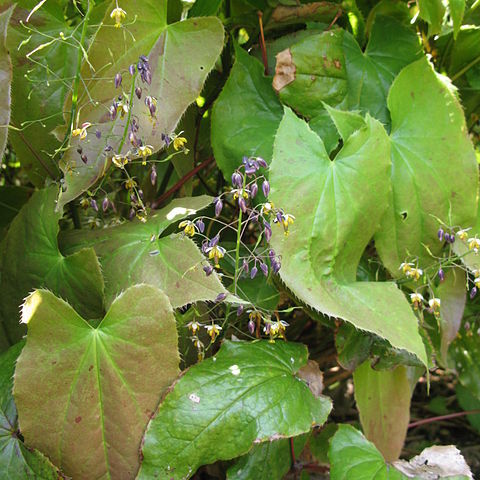Herbs, 30-50 cm tall. Rhizome short, stout, nodose, with numerous fibrous roots. Leaves basal and cauline, trifoliolate; leaflets ovate to ovate-lanceolate, 5-19 × 3-8 cm, leathery, abaxially sparsely strigose or glabrous, adaxially glabrous, base deeply or shallowly cordate, apex acute or acuminate, terminal leaflet with equal rounded lobes or oblong, lateral leaflets oblique with outer lobe large, deltoid and acute, inner lobe smaller and rounded, margin closely spinulose-subserrulate. Flowering stem with 2 opposite trifoliolate leaves. Panicle 10-20(-30) × 2-4 cm, 20-60-flowered, sometimes with lower peduncles 3-flowered, usually glabrous, occasionally scarcely glandular pubescent. Pedicel ca. 1 cm, glabrous. Flowers white or yellow, ca. 8 mm or less in diam. Outer sepals 4, purple spotted, apex blunt, outer pair narrowly ovate, ca. 3.5 × 1.5 mm, inner pair oblong-ovate, ca. 4.5 × 2 mm; inner sepals white, ovate-deltoid, ca. 4 × 2 mm, apex acute. Petals brownish yellow, saccate, 1.5-4 mm, blunt. Stamens prolonged, 3-5 mm; anthers 2-3 mm. Pistil ca. 3 mm; style longer than ovary. Capsules ca. 1 cm; style ca. 6 mm. Fl. (unknown in var. glabratum) Apr-May, fr. (Apr-)May-Jul. 2n = 12*.
More
An evergreen herb. It keeps growing from year to year and has creeping underground stems or rhizomes. The leaves have 3 leaflets and are leathery. The leaflets are oval to sword shaped and 5 cm long. There are spiny teeth along the edge. The flowers are pale yellow and in groups of 20-60.
It is a temperate plant. It grows in forests, on slopes and along streams between 200-1,800 m above sea level in China.
More
Hillsides in damp shady bamboo groves or in cliff crevices. Moist woodlands.

